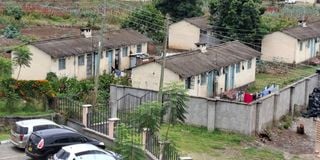Kivumbini residents sell old asbestos roofing for profit, as calls for removal intensify

Asbestos roofing on some of the staff quarters at Nakuru county teaching and referral hospital. Photo taken on March 15, 2025.
On March 11,2025, the Cabinet issued a fresh directive for the complete removal of asbestos roofing in many public and private buildings, in a bid to mitigate the health risks associated with asbestos exposure.
Despite a 2006 ban and other subsequent bans on asbestos, due to its carcinogenic effects, many residential homes and public institutions still have roofs made from this hazardous material.
Frank Morei, a resident of Kaloleni C, expressed his concerns about the selective sensitization efforts in Nakuru East, particularly in areas like Kaloleni A, B, C, and Kivumbini 2, where many homes still have asbestos roofs.
According to Morei, the sensitization campaigns primarily target the ‘wazee wa nyumba kumi’ (community leaders), who then spread the word to a few others.
However, he notes that the process lacks broad community engagement, leaving many people unaware of the dangers.
Despite a chance to attend a public participation forum in 2024, when he heard the issue talked about last, during budget allocation discussions, Morei says little has been done since then to address the issue effectively.
He adds, “Almost 60 percent of the removal of asbestos has actively happened since the second MCA came into power. Although slow, our leaders have made it their project to renovate the estates by changing the roofing.”
However, Morei remains critical of the government for inadequate sensitization efforts, particularly because many residents remain uninformed about the dangers of asbestos.
“Even after the roofs were removed, they were left with us. Many people used them to build house extensions and even chicken coops. The disposal is still a major problem,” he says.
In fact, Morei says that upon removal of the asbestos roofing, some people have made a business out of the problem and sell a meter of it for Sh. 40.
Others store them for when the need arises or sell them to readily available customers.
“A lot of people here have seen their grandparents, parents and now themselves live in houses with asbestos roofing and nothing ever happened to them. How do you expect to convince this person that the material is harmful to their health? Over and above this, not everyone keeps up with the news or the latest study to know the extent of this,” he says frustratingly urging the government to conduct door-to-door sensitization, explain in detail the harmful effects of the roofing material and the benefits they gain in converting to other materials.
On his part, the CECM for Water, Environment, Energy and Natural Resources, Dr. Nelson Maara, told Mtaa Wangu over a phone call interview, that the county has been conducting sensitization through its sub-county environment officers, more so in Nakuru East and West, on the dangers of asbestos as they look at their budgets.
“The sensitization efforts and changing of the roofing material need a lot of resources pumped into the exercise. We are assessing our budgets to be able to buy other roofing materials for residents. For now, we are trying to talk to the people to educate them on the dangers of asbestos,” says Dr. Maara.
When asked about the reuse of the asbestos roofing material, Dr. Maara responded that it cannot be reused and stated that households are not reusing the asbestos roofing, contrary to Morie’s claims.
Despite the big monetary implications which Dr. Maara insists on, he says the sensitization will continue targeting both renters and property owners.
